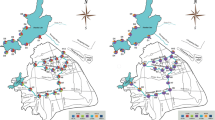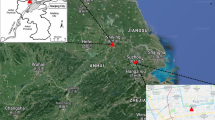Abstract
Stormwater runoff samples were collected from five different land use sites (gas station, city road, campus, park, and residential) in a precipitation event on May 22nd, 2017, from a small suburban area (5 km × 2 km) of the city of Beijing, China. There were 72 types of semi-volatile organic compounds (SVOCs) found in these runoff samples, including 33 types of monocyclic aromatic hydrocarbons (MAHs), 22 types of polycyclic aromatic hydrocarbons (PAHs), 6 types of phthalate esters (PAEs), 9 types of pesticides and 2 types of polychlorinated biphenyls (PCBs). Especially, 26 types of SVOCs (7 MAHs, 9 PAHs, 5 PAEs, and 5 pesticides) were detected in all water samples. SVOCs concentrations were higher in the samples from gas station and city road, and lower in runoff from campus, park and residential sites. The change in the ratio of anthracene to anthracene plus phenanthrene (ANT/(ANT + PHE)) in this study, reflected the importance of PAH source and land use. Di-2-ethylhexyl phthalate (DEHP) and di-n-butyl phthalate, are two of the phthalate esters 100% detected in the runoff samples. The city road runoff DEHP concentrations recorded the highest values (> 6000 ng/L), however, were still less than those wastewater DEHP pollutants measured in developed countries (e.g. UK, Canada, Finland, etc.). One-way ANOVA analysis in this study, showed that land use could significantly influence 23 SVOCs in the runoff samples, whereas the runoff SVOCs in different precipitation period showed no statistical changes in the five sites, and presented a general temporal trends “high (beginning)—low (middle period)—little raising (ending)”. The findings in this study could be used in municipal management of wastewater collection and treatment.


source: Daxin Meteorological Office, City of Beijing). The red arrows represent the sampling time points (“0” min, 5th min, 15th min, 25th min, 40th min, and 50th min)

Similar content being viewed by others
References
Armstrong B, Hutchinson E, Unwin J, Fletcher T (2004) Lung cancer risk after exposure to polycyclic aromatic hydrocarbons: a review and meta-analysis. Environ Health Perspect 112:970–978
ATSDR (Agency for Toxic Substances and Disease Registry USA) (2006) US Department of health and human services, Atlanta, Georgia
Baldys S, Raines TH, Mansfield BL, Sandlin JT (1998) Urban stormwater quality event-mean concentrations and estimates of stormwater pollutant loads Dallas-Fort Worth area Texas 1992–1993 US geological survey water-resources investigation report 98–4158, 51
Barrett ME, Zuber RD, Collins ER III, Malina JF, Charbeneau RJ, Ward GH (1993) A review and evaluation of literature pertaining to the quantity and control of pollution from highway runoff and construction: Austin, Tex. Center for research in water resources technical report CRWR 239
Budzinski H, Jones I, Bellocq J, Pierard C, Garrigues P (1997) Evaluation of sediment contamination by polycyclic aromatic hydrocarbons in the Gironde estuary. Mar Chem 58:85–97
Campo J, Masia A, Blasco C, Pico Y (2013) Occurrence and removal efficiency of pesticides in sewage treatment plants of four Mediterranean River Basins. J Hazard Mater 263P:146–157
Chen L, Jin S, Liu Y, Liu F (2014) Presence of semi-volatile organic contaminants in shal-low groundwater of selected regions in China. Groundw Monit Remediat 34:33–43
Clara M, Windhofer G, Hartl W, Braun K, Simon M, Gans O, Scheffknecht C, Chovanec A (2010) Occurrence of phthalates in surface runoff untreated and treated wastewater and fate during wastewater treatment. Chemosphere 78:1078–1084
Cruzeiro C, Pardal MA, Rocha E, Rocha MJ (2015) Occurrence and seasonal loads of pesticides in surface water and suspended particulate matter from a wetland of worldwide interest-the Ria Formosa Lagoon Portugal. Environ Monit Assess 187(11):669
Domagalski J (1996) Pesticides and pesticide degradation products in stormwater runoff: sacramento river basin California. Water Resour Bull 32:953–964
DXSB (Daxin District Statistic Bureau) (2018) The 2017 statistical bulletin of Daxin District City of Beijing http://www.bjdxgovcn/docs/2018-11/20181119094552240038pdf
Ensminger M, Bergin R, Spurlock F, Goh KS (2011) Pesticide concentrations in water and sediment and associated invertebrate toxicity in Del Puerto and Orestimba Creeks California 2007–2008. Environ Monit Assess 175:573–587
Fadaei A, Dehghani MH, Nasseri S, Mahvi AH, Rastkari N, Shayeghi M (2012) Organ-ophosphorous pesticides in surface water of Iran. Bull Environ Contam Toxicol 88:867–869
Fatoki OS, Bornman M, Ravandhalala L, Chimuka L, Genthe B, Adeniyi A (2010) Phthalate ester plasticizers in freshwater systems of Venda South Africa and potential health effects. Water SA 36:117–126
Gao J, Liu L, Liu X, Zhou H, Lu J, Huang S, Wang Z (2009) The occurrence and spatial distribution of organophosphorous pesticides in Chinese surface water. Bull Environ Contam Toxicol 82:223–229
Harino H, Yatsuzuka E, Yamao C, Ueno M, Ohji M (2014) Current status of organophosphorus compounds contamination in Maizuru Bay, Japan. J Mar Biol Assoc UK 94:43–49
Hartmann PC, Quinn JG, Cairns RW, King JW (2004) The distribution and sources of polycyclic aromatic hydrocarbons in Narragansett Bay surface sediments. Mar Pollut Bull 48:351–358
Hashizume K, Nanya J, Toda C, Yasui T, Nagano H, Kojima N (2002) Phthalate esters detected in various water samples and biodegradation of the phthalates by microbes isolated from river water. Biol Pharm Bull 25:209–214
Hoffman EJ, Quinn JG (1987) Chronic hydrocarbon discharges into aquatic environments—II-Urban runoff and combined sewer overflows. In: Vandermeulen JH, Hrudey SE (eds) Oil in freshwater-chemistry biology countermeasure technology: pergamon press new york proceedings of the symposium of oil pollution in freshwater edmonton alberta Canada. p 114–137
Huang P, Tien C, Sun Y, Hsieh C, Lee C (2008) Occurrence of phthalates in sediment and biota: relationship to aquatic factors and the biots-sediment accumulation factor. Chemosphere 73:539–544
IARC (International Agency of Research on Cancer) (1983) Polynuclear aromatic compounds part 1: chemical environmental and experimental data. IARC Mongraphs Eval Carcinog Risks Human 32:1–477
Kambia K, Dine T, Gressier B, Germe AF, Luyckx M, Brunet C, Michaud L, Gottrand F (2001) High-performance liquid chromatographic method for the determination of di (2-ethylhexyl) phthalate in total parenteral nutrition and in plasma. J Chromatogr B 755:297–303
Kuo J, Soon AY, Garrett C, Wan MTK, Pasternak JP (2012) Agricultural pesticide residues of farm runoff in the Okanagan Valley British Columbia Canada. J Environ Sci Health B 47:250–261
Lesser LE, Mora A, Moreau C, Mahlknecht J, Hernández-Antonio A, Ramírez AI, Barrios-Piña H (2018) Survey of 218 organic contaminants in groundwater derived from the world’s largest untreated wastewater irrigation system: Mezquital Valley Mexico. Chemosphere 198:510–521
Loizeau V, Ciffroy P, Roustan Y, Musson-Genon L (2014) Identification of sensitive parameters in the modeling of SVOC reemission processes from soil to atmosphere. Sci Total Environ 93:419–431
Lopes TJ, Dionne SG (1998) A review of semivolatile and volatile organic compounds in highway runoff and urban stormwater: US geological survey open file report 98–409 67 p
Mai BX, Qi SH, Zeng EY, Yang QS, Zhang G, Fu JM, Sheng GY, Peng PA, Wang ZS (2003) Distribution of polycyclic aromatic hydrocarbons in the coastal region of Macao China: assessment of input sources and transport pathways using compositional analysis. Environ Sci Technol 37:4855–4863
Richards J, Reif R, Luo Y, Gan J (2016) Distribution of pesticides in dust particles in urban environments. Environ Pollut 214:290–298
Selvaraj KK, Sundaramoorthy G, Ravichandran PK, Girijan GK, Sampath S, Ramaswamy BR (2015) Phthalate esters in water and sediments of the Kaveri River India: environmental levels and ecotoxicological evaluations. Environ Geochem Health 37:83–96
Sha Y, Xia X, Yang Z, Huang GH (2007) Distribution of PAE in the middle and lower reaches of the Yellow River China. Environ Monit Assess 124:277–287
Shanker RC, Ramakrichma C, Seth PK (1985) Degradation of some phthalic acid esters in soil. Environ Pollut 39:1–5
Shea KM (2003) American academy of pediatrics committee on environmental health: pediatric exposure and potential toxicity of phthalate plasticizers. Pediatrics 111:1467–1474
Simpson CD, Mosi AA, Cullen WR, Reimer KJ (1996) Composition and distribution of polycyclic aromatic hydrocarbons in surficial marine sediments from Kitimat Harbour Cananda. Sci Total Environ 181:265–278
Song Y, Shao M, Liu Y, Lu S, Kuster W, Goldan P, Xie S (2007) Source apportionment of ambient volatile organic compounds in Beijing. Environ Sci Technol 41:4348–4353
Tang X, Yang Y, Tam N, Tao R, Dai Y (2019) Pesticides in three rural rivers in Guangzhou China: spatiotemporal distribution and ecological risk. Environ Sci Pollut Res 26:3569–3577
Tran BC, Teil MJ, Blanchard M, Alliot F, Chevreuil M (2015) BPA and phthalate fate in a sewage network and an elementary river of France Influence of hydroclimatic conditions. Chemosphere 119:43–51
Tsuda T, Nakamura T, Inoue A, Tanaka K (2009) Pesticides in water fish and shellfish from Littoral area of lake Biwa. Bull Environ Contam Toxicol 82:716–721
United States Centers for Disease Control and Prevention (USCDCP) (2009 https://www.cdcgov/biomonitoring/pdf/Pthalates_FactSheetpdf. Accessed on 29 Mar 2019
Von der Ohe PC, Dulio V, Slobodnik J, De Deckere E, Kühne R, Ebert RU et al (2011) A new risk assessment approach for the prioritization of 500 classical and emergingorganic microcontaminants as potential river basin specific pollutants under the Eu-ropean Water Framework Directive. Sci Total Environ 409:2064–2077
Wang L, Jiang G, Cai Y, He B, Wang Y, Shen D (2007) Cloud point extraction coupled with HPLC-UV for the determination of phthalate esters in environmental water samples. J Environ Sci 19:874–878
Wee SY, Aris AZ (2017) Endocrine disrupting compounds in drinking water supply system and human health risk implication. Environ Int 106:207–233
Weschler CJ, Nazaroff WW (2008) Semivolatile organic compounds in indoor environments. Atmos Environ 42:9018–9040
Yuan B, Li X, Graham N (2008) Aqueous oxidation of dimethyl phthalate in a Fe(VI)-TiO2-UV reaction system. Water Res 42:1413–1420
Yunker MB, Macdonald RW, Vingarzan R, Mitchell RH, Goyette D, Sylvestre S (2002) PAHs in the Fraser River Basin; a critical appraisal of PAH ratios as indicators of PAH source and composition. Org Geochem 32:489–515
Acknowledgements
This research was supported by National Key R&D Program of China (2017YFC0703300); The Fundamental Research Funds for Beijing Universities (X18106); Great Wall Scholars Program (CIT&TCD20170313); Natural Science Foundation of China (Grant No. 51678025) and Sponge City Development and Water Quantity & Quality Risk Control (UDC2016040100); Youth Top Talents Training Program of Beijing Municipal Education Commision (CIT&TCD201804052).
Author information
Authors and Affiliations
Corresponding authors
Ethics declarations
Conflict of interest
All authors have no potential conflict of interest
Supplementary Information
Below is the link to the electronic supplementary material.
Rights and permissions
About this article
Cite this article
Zhang, L., Li, H., Wang, Y. et al. Characterizing the Semi-Volatile Organic Compounds in Runoff from Roads and Other Impervious Surfaces in a Suburban Area of Beijing. Arch Environ Contam Toxicol 82, 227–238 (2022). https://doi.org/10.1007/s00244-021-00884-6
Received:
Accepted:
Published:
Issue Date:
DOI: https://doi.org/10.1007/s00244-021-00884-6




